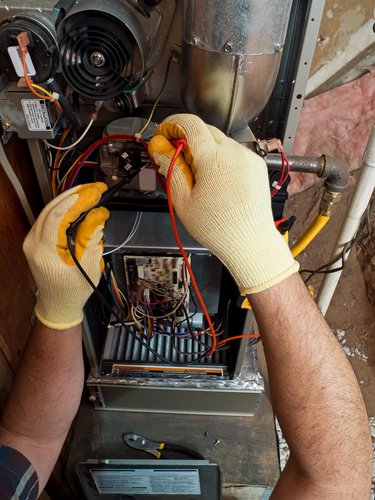 When is it time to replace your gas furnace? Each homeowner will come up with a different answer, but it all boils down to a very basic cost-benefit analysis. When the benefits of installing new heating equipment outweigh the costs of the equipment and installation, then it is time to go ahead with the replacement.
When is it time to replace your gas furnace? Each homeowner will come up with a different answer, but it all boils down to a very basic cost-benefit analysis. When the benefits of installing new heating equipment outweigh the costs of the equipment and installation, then it is time to go ahead with the replacement.
Griffith Energy Services recommends replacement of old heating equipment in two common scenarios: Either the equipment has failed and requires major repairs, or the operating cost of the equipment is too high. Let’s look at both possibilities and consider whether or not replacement is the best option.
Scenario 1: The Equipment Has Failed
Furnaces have a life expectancy of 25 years. They can last longer with good maintenance and some occasional replacement parts, and they will certainly fail sooner with poor maintenance, but 25 years is a good rule of thumb. One of the most commonly encountered problems with old furnaces is that they were purchased with the house, and the owner doesn’t really know how old they are or how they have been treated.
Unexpected furnace downtime is inconvenient and costly. Heat is needed or else you wouldn’t know that the furnace isn’t working, and that means you are probably uncomfortable and in a hurry to get repairs made. Unfortunately, being in a hurry often leads to poor decisions. Furnace replacement is best considered when you are warm and have time to budget for the expense. The following warning signs may alert you to impending furnace failure even when you don’t know the age or maintenance history of the equipment.
Is There A Pilot Light?
Modern gas furnaces fire electronically. If your furnace has a pilot light, then it’s a safe bet that it is old enough to consider replacement. Age alone is no reason to replace a furnace, but design advances and increased operating efficiency achieved over the past 20 years may make replacement a good option.
Is Your Gas Usage Increasing?
Your gas bill is undoubtedly going up each year because fuel costs have been increasing, but an increasing utility bill may also be due to increased consumption. Look at the usage figures on your bill. Are you using more cubic feet of gas this month than you have for the same month in previous years? If so, then your furnace may be losing efficiency. It is running for longer periods of time, or more frequently, to provide the same level of warmth that it did previously. Older furnaces are less efficient than modern ones, but the inefficiency should be constant. Dropping efficiency is a strong sign that your furnace needs maintenance or replacement.
Is The Furnace Talking To You?
Do you hear the blower kicking on and off more frequently than usual? Do you hear popping sounds or rattling or squealing noises? These can all be warning signs. The furnace should run quietly. If it doesn’t, or if you hear it running more than usual, then maintenance or replacement may be necessary.
Does There Seem To Be A Lot Of Static Electricity In Your Home?
Humidity levels are low in the cold winter air, but modern furnaces do a great job of adding moisture to the air they heat. Static electricity increases as humidity levels drop. Increased static electricity may be a sign of low humidity levels, and low humidity levels could mean that your furnace isn’t doing a good job of moisturizing the air. Other signs of low humidity are dry skin or nose, musical instruments that won’t stay in tune, cracking wood or wilting houseplants.
Did You Have Furnace Repairs Last Year?
Studies show that furnaces incur the most repair costs during the last two years of their useful life. If you had repairs made last year and have additional repairs required this year, then it may be time to replace your furnace. If the repairs require parts that the contractor doesn’t have in stock, you should take that as another warning sign. Service contractors typically don’t stock parts for old equipment, and their inventory may be an indication of your equipment’s age.
Are There Any Signs Of Carbon Monoxide?
Carbon monoxide is a colorless, odorless gas that binds with the hemoglobin in our blood in place of oxygen. It can leak from cracked furnace heat exchange manifolds, and any signs of carbon monoxide mean that the furnace should be replaced.
A yellow flame instead of a blue flame at the burner is a sign of incomplete combustion and carbon monoxide production. Excess humidity in the home is another sign that something is amiss, and rusty vent pipes are another bad sign. Carbon monoxide has no odor, but you may feel nauseated or have headaches when you are exposed to it. These are all warning signs that your furnace isn’t operating properly and may need repairs or replacement.
Scenario 2: Efficiency Is Driving The Replacement
Old gas-burning heating equipment typically has an efficiency rating around 65 percent. Modern furnaces typically have AFUE ratings of 80 to 90 percent, and new Energy Star-qualified gas furnaces operate at 90 to 98 percent efficiency. It may be that replacing an old furnace with a new model makes financial sense just because of the increased efficiency.
As an example, consider an old 65 AFUE gas furnace and a December gas utility bill of $250. Sixty-five percent of the gas burned by the furnace is converted to heat in the home and 35 percent of the gas burned is wasted. A high efficiency Energy Star-qualified furnace with an AFUE of 97, on the other hand, converts 97 percent of the gas burned to heat and wastes only three percent. On a utility bill of $250, this equates to a savings of $80 per month. If the new furnace costs $3,000, and if you operate the furnace for four months out of the year, then you will be saving $320 per year. In the example situation, the furnace will pay for itself in about nine years and four months. If it remains in operation for the expected 25 years, you will have earned almost $5,000 from the replacement that would otherwise have gone to the gas company.
Scenario 3: A Little Of Both
If you are facing repairs to an old furnace, upgrading to a new, high efficiency model becomes even more attractive. A potential $500 repair bill means that you are really only spending an additional $2,500 to get that $3,000 replacement furnace, and the payback period is shortened by another year or two. This is probably the scenario that describes most replacement situations.
At Griffith Energy Services, our friendly technicians are available at any time of the day or night for emergency repairs, and we offer maintenance contracts at multiple levels of service on all makes and models of HVAC equipment. We perform scheduled service on oil, gas or electric furnaces, and we are happy to talk with you about the advantages of replacing your heating system if that is the best option. We are also honest enough to tell you when you are better off repairing your existing system. We want your repeat business, and we earn it by providing the best service and support in the industry. Contact us for all of your heating service needs.
Image Provided by Shutterstock.com
Written by Kevin Spain



